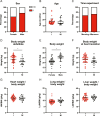Arrhythmia Inducibility in the CAVB Dog Model, A Critical Analysis on Underlying Factors
- PMID: 40553351
- PMCID: PMC12310751
- DOI: 10.1007/s12012-025-10033-3
Arrhythmia Inducibility in the CAVB Dog Model, A Critical Analysis on Underlying Factors
Abstract
The dog with chronic atrioventricular block (CAVB) combines a number of risk factors associated with Torsade de Pointes (TdP) arrhythmias. Nevertheless, approximately 33% of the animals are resistant to dofetilide-induced TdP arrhythmia. Of a group of 78 experimentally identical CAVB dogs, we compared TdP inducible vs. non-inducible animals for a set of basic, and cardiac electrical and mechanical parameters. Body weight, but not sex or age, is associated with TdP inducibility. Of the cardiac parameters, longer ventricular repolarization duration and increased contractility at baseline are associated with dofetilide-induced TdP arrhythmias. Differences in cardiac parameters disappeared upon dofetilide infusion. We discuss that prolonged repolarization and increased contractility may be early indications of calcium-mediated early after depolarization that may develop into TdP arrhythmias.
Keywords: AV block dog model; Arrhythmia predisposition; Remodeling; Torsade de pointes.
© 2025. The Author(s).
Conflict of interest statement
Declarations. Conflict of Interest: Marcel AG van der Heyden is Associate Editor of Cardiovascular Toxicology. Ethical Approval: Full experimental details including notifications on ARRIVE guidelines can be found in the associated publications, as referred to in the methods section. An earlier version of this manuscript was published in the thesis entitled ‘’Drug and device testing in a preclinical model sensitive to cardiac arrhythmias’’ by JJA van Bavel.
Figures



Similar articles
-
Ventricular remodelling is a prerequisite for the induction of dofetilide-induced torsade de pointes arrhythmias in the anaesthetized, complete atrio-ventricular-block dog.Europace. 2012 Mar;14(3):431-6. doi: 10.1093/europace/eur311. Epub 2011 Sep 22. Europace. 2012. PMID: 21946817
-
Vernakalant is devoid of proarrhythmic effects in the complete AV block dog model.Eur J Pharmacol. 2013 Nov 15;720(1-3):49-54. doi: 10.1016/j.ejphar.2013.10.054. Epub 2013 Nov 5. Eur J Pharmacol. 2013. PMID: 24211677
-
The electromechanical window is no better than QT prolongation to assess risk of Torsade de Pointes in the complete atrioventricular block model in dogs.Br J Pharmacol. 2014 Feb;171(3):714-22. doi: 10.1111/bph.12483. Br J Pharmacol. 2014. PMID: 24490860 Free PMC article.
-
Point of View: Electrophysiological Endpoints Differ When Comparing the Mode of Action of Highly Successful Anti-arrhythmic Drugs in the CAVB Dog Model With TdP.J Cardiovasc Pharmacol. 2019 Dec;74(6):499-507. doi: 10.1097/FJC.0000000000000748. J Cardiovasc Pharmacol. 2019. PMID: 31738198 Review.
-
Short-term Variability of Repolarization Is Superior to Other Repolarization Parameters in the Evaluation of Diverse Antiarrhythmic Interventions in the Chronic Atrioventricular Block Dog.J Cardiovasc Pharmacol. 2017 Jun;69(6):398-407. doi: 10.1097/FJC.0000000000000488. J Cardiovasc Pharmacol. 2017. PMID: 28574954 Free PMC article. Review.
References
-
- Cohagan B, Brandis D. Torsade de Pointes. StatPearls. Treasure Island (FL) 2023. - PubMed
-
- Tisdale, J. E., Chung, M. K., Campbell, K. B., et al. (2020). Drug-induced arrhythmias: A scientific statement from the American Heart Association. Circulation,142(15), e214–e233. - PubMed
-
- Oros, A., Beekman, J. D., & Vos, M. A. (2008). The canine model with chronic, complete atrio-ventricular block. Pharmacology & Therapeutics,119(2), 168–178. - PubMed
-
- Weissenburger, J., Davy, J. M., & Chézalviel, F. (1993). Experimental models of torsades de pointes. Fundamental & Clinical Pharmacology,7(1), 29–38. - PubMed
MeSH terms
Substances
LinkOut - more resources
Full Text Sources

